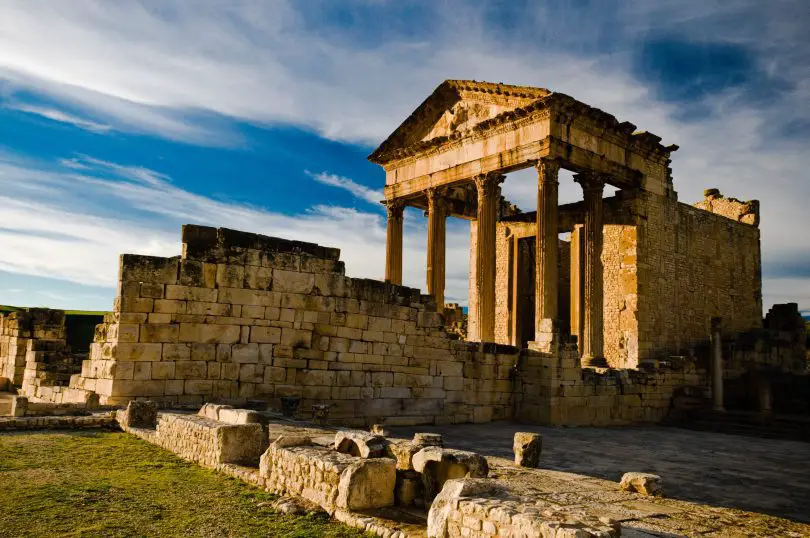From the mighty ruins of Carthage to mysterious graves that puzzle historians, there are several fascinating historical sites in Tunisia. Its strategic location along the Mediterranean Sea coastline and proximity to the Sahara attracted conquerors throughout the years. From Romans to Arabs and lastly the French, Tunisia was under the rule of the strongest for years before eventually gaining independence in 1956.
With the power shift and struggles, numerous historical sites came into existence, making this North African country an incredible destination for all history lovers. Below are five historical sites in Tunisia you shouldn’t miss during your visit:
Table of Contents
1. The Ruins of Carthage
Located near Tunisia’s capital city Tunis, Carthage is one of the most visited historical sites in Tunisia. Once the epicentre of the powerful Carthaginian Empire, Carthage met its demise in the Punic Wars against Rome.

The Ruins of Carthage. Photo/ Trip.com.
The Ruins of Carthage provide a rich exploration of both Punic and Roman history as visitors can explore remnants of both cultures, including the Roman baths of Antoninus and Punic ports. The destruction and downfall of Carthage happened in 146 BC.
2. Dougga
Also known as Thugga, Dougga is one of the historical sites in Tunisia you can’t miss during your trip. It is situated in the North-west region of Tunisia, perched on the summit of a hill at an altitude of 571 m. The archaeological site has existed for more than six centuries.

Dougga is a UNESCO World Heritage Site. Photo/ Carthage Magazine.
Dougga is the location of well preserved ruins of an ancient site previously inhibited by different cultures, including the Greeks, Romans, and the Punics. It was listed as a UNESCO World Heritage Site in 1997 and has since been drawing large number of tourists to Tunisia every year.
3. El Jem Amphitheater
El Jem Amphitheater, also known as El Djem, is an incredibly large and well preserved Roman amphitheater in Tunisia. According to reports, it is a 3rd-century monument that could house around 60,000 people in it’s prime, which highlights its sheer size.
The amphitheater was constructed by Emperor Gordian between 230 and 238AD. It is built entirely of stone blocks, with no foundations and free-standing. It’s size is 162m long by 118m wide and no other amphitheater in north Africa comes close to it in terms of size.

El Jem Amphitheater. Photo/ Kami and the Rest of the World.
4. Bulla Regia
Bulla Regia is an area in Tunisia boasting numerous monuments, public buildings and its own amphitheater. It was very prominent during the Roman era and has since become a major tourist attraction in present day Tunisia. Amongst the remains of Bulla Regia are the two-storey villas, with some of the villas containing original Roman mosaics.
Bulla emerged in the 5th century and the Regia (which means royal) was added later when it became the capital of one of the Numidian kingdoms. Bulla Regia is located 7 kilometres northwest of Jendouba.
5. Enfidaville War Cemetery
You can’t talk about historical sites in Tunisia and fail to mention Enfidaville War Cemetery. This World War Two Commonwealth cemetery houses the graves of 1,551 soldiers who died in the course of the North Africa Campaign, particularly the Tunisia Campaign. There are a total of 1,551 graves, and of these graves, 88 are unidentified. Most of the people buried in the cemetery perished towards the end of the war in the period of March to May 1943.

Enfidaville War Cemetery. Photo/ Commonwealth War Graves Commission.
How many World Heritage Sites Are in Tunisia?
Tunisia has nine World Heritage Sites, eight of which are listed for their cultural significance and one for natural significance. Whereas the first three sites were listed in 1979, the most recent one was added last year (2023).
What Is Tunisia’s Famous Landmark?
Medina of Tunis is arguably the most famous landmark in Tunisia. Being a fascinating area, it is worth exploring on foot.
What Is the Most Famous Historical Site?
Some of the most famous historical sites in the world include:
- Taj Mahal
- Leaning Tower of Pisa
- Khai Dinh Tomb
- The Colosseum
- Great Sphinx of Giza
What Is the Ancient Site in Tunisia?
Listed as a UNESCO World Heritage Site in 1997, Dougga (Thugga) is the most magnificent Roman complex in Tunisia. It is one of the many settlements that the Romans inherited.








